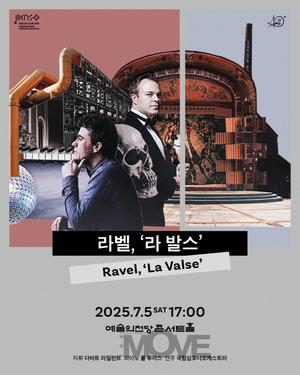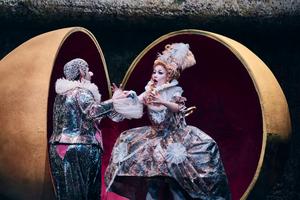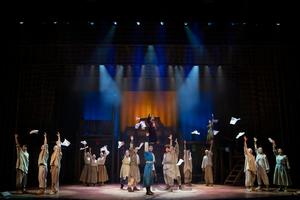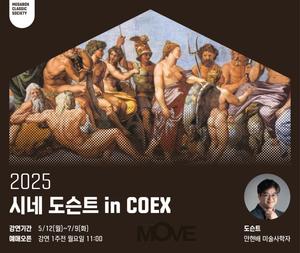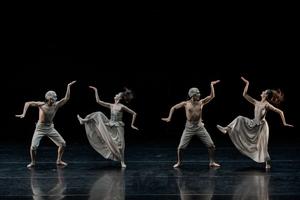- <2021 한국창작음악 페스티벌(KNMF)> 콘체르트하우스 베를린에서 개최
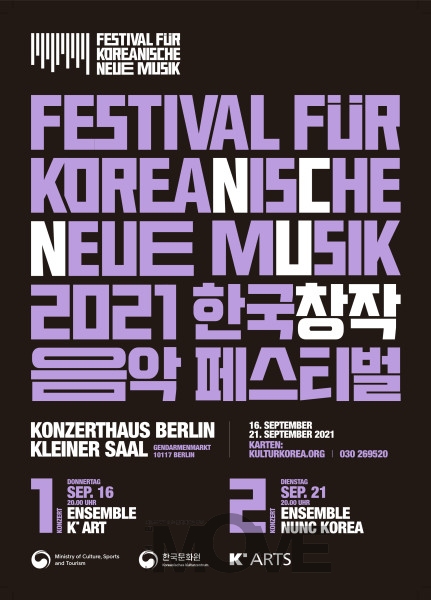 |
Festival für Koreanische Neue Musik -
- 독일 콘체르트하우스 베를린에서 국내 작곡가들 이틀간의 콘서트
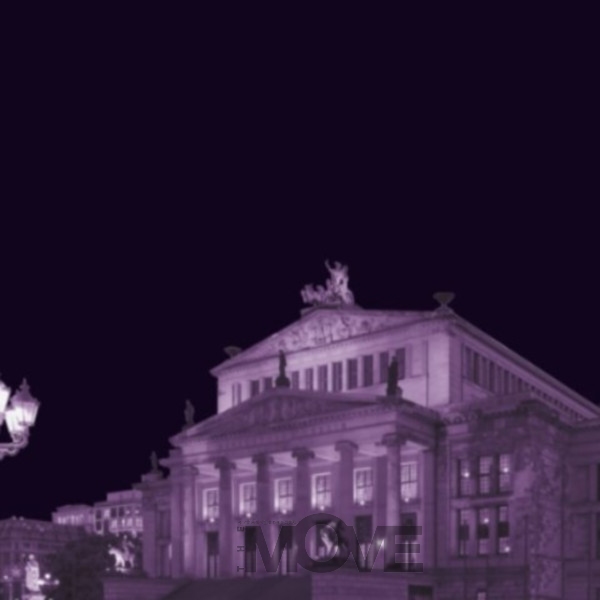 |
| 콘체르트 하우스 베를린 |
한국예술종합학교 전통예술원 X 독일 베를린 한국문화원
독일 베를린 ‘2021 한국창작음악 페스티벌’ 초청
전통예술원 임준희 원장, 한국음악작곡과 이귀숙, 음악과 류경화 교수 작품 발표
새로운 한국 현대음악을 유럽 클래식의 본고장인 독일에 알리기 위해 기획된 <한국창작음악페스티벌>이 올해 3회째 맞아 35명의 작곡가들이 참가해 독일 베를린에서 공연한다.
한국예술종합학교(총장 김대진, 이하 한예종) 전통예술원은 9월 16일(목), 21일(화) 2일간 베를린 콘체르트하우스 체임버홀에서 개최하는 <2021 베를린 한국 창작음악 페스티벌Festival für Koreanische Neue Musik 2021>에 참가한다.
한국 악기와 기존 서양 악기의 조화를 들려주고 경쟁력이 기대되는 한국창작음악페스티벌은
특화된 우리 현대음악을 현지에 소개하기 위한 일환으로 기획됐다. 정통클래식 및 국악만으로 유럽 현지에서 경쟁력 부족의 보완 및 한국의 새로운 음악으로 현지 경쟁력을 확보하고자 한다. 또한, 유럽에 소개가 전무한 한국 현대음악 작곡가 및 창작음악 소개함과 더불어 한국예술종합학교 전통예술원과 공동주최를 통해 시너지를 극대화하여 효과적이고 효율적인 한국 창작음악의 발전 도모하고자 한다.
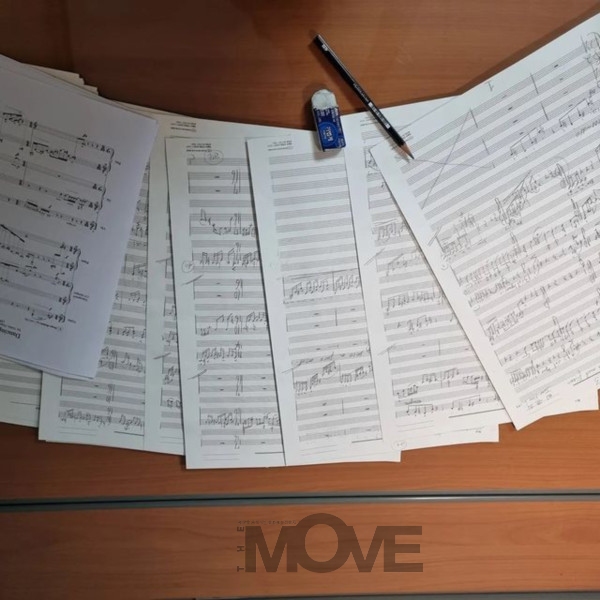 |
지난해 아르코 아창제에서 진행된 페스티벌을 올해는 한국예술종합학교 전통예술원에서 주 독일 한국문화원과 공동주최로 베를린 최고 양대 연주홀 중 하나인 콘체르트하우스(체임버홀)에서 개최한다.
한국 전통음악의 정수와 현재 살아있는 한국현대음악의 현장을 보여주고자 하며,
베를린 외에도 독일 본 대사관과 스위스 대사관의 초청으로 쾰른, 스위스에서도 공연할 예정이다. 16일과 21일 양일은 베를린에서, 23일 쾰른, 25일은 스위스 베른에서 공연한다.
30여 명의 아티스트들은 코로나에 대응해 전원 백신을 맞고 각오를 다지며 준비하고 있다.
(페스티벌 로고는 세종대왕이 음악의 기본음을 정하기 위해 12음을 대나무관으로 제작, 발명한 ‘율관’을 모티브로 제작됐다.)
한국예술종합학교 전통예술원에서 진행하는 예술한류 전통예술 선도사업은 2021년을 시작으로 전통음악의 창작 및 교육 콘텐츠의 해외진출 및 한류 확산을 목표로 장기적인 교류 계획을 수립하는 사업이다. 해외예술대학 교류, 한류확산, 해외진출 창·제작 및 한류문화 교육 사업을 진행 예정이며, 전통예술원의 재학생 및 졸업생들의 해외 일자리 창출과 창·제작된 콘텐츠를 국제적 교류 확대 등을 통하여 전통예술의 우수성과 함께 국가 이미지 위상을 극대화 시킬 것이다.
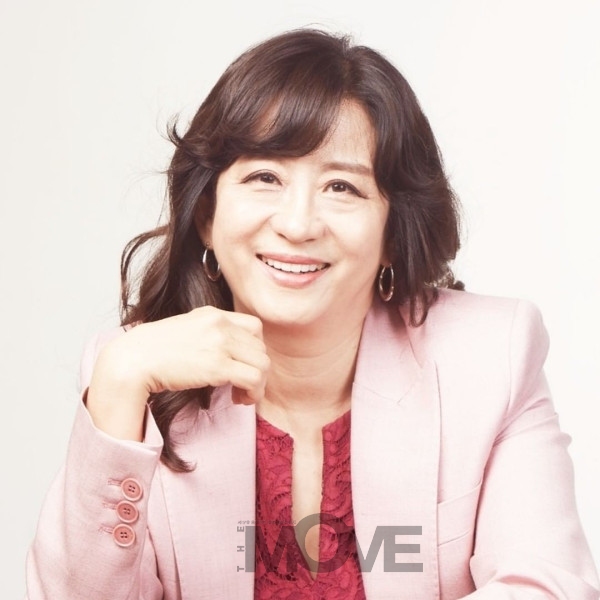 |
| 한국예술종합학교 전통예술원 임준희 원장 |
이번 ‘2021 베를린 한국 창작음악 페스티벌’에는 전통예술원 임준희 원장 외 전통예술원 강사 및 전통예술원 출신 졸업생 및 재학생과 독일의 우수한 연주자들과 함께 참가하여 발표 및 연주를 하게 된다.
9월 16일은 <이귀숙-피아노와 2인 타악주자를 위한 “더미”>, <류경화-흩은가락>, <계성원-대금, 가야금, 거문고를 위한 3중주 “다시!”>, <강상구-세한도> 등의 작품들을, 9월 21일은 <임준희-댄싱산조3>, <임준희-파초우>, <류경화-망각의 새>, <원일-엇농> 등을 내보일 예정이다.
이번 ‘2021 베를린 페스티벌’ 참가는 베를린 한국문화원과 한국예술종합학교 전통예술원의 꾸준한 교류와 이를 통해 한국음악의 우수성을 알리고 유럽진출의 발판을 삼을 수 있는 계기가 될 것이다.
16일(목), 21일(화) 19:00 / 베를린 콘체르트 하우스 체임버홀 공연(KleinSaal)
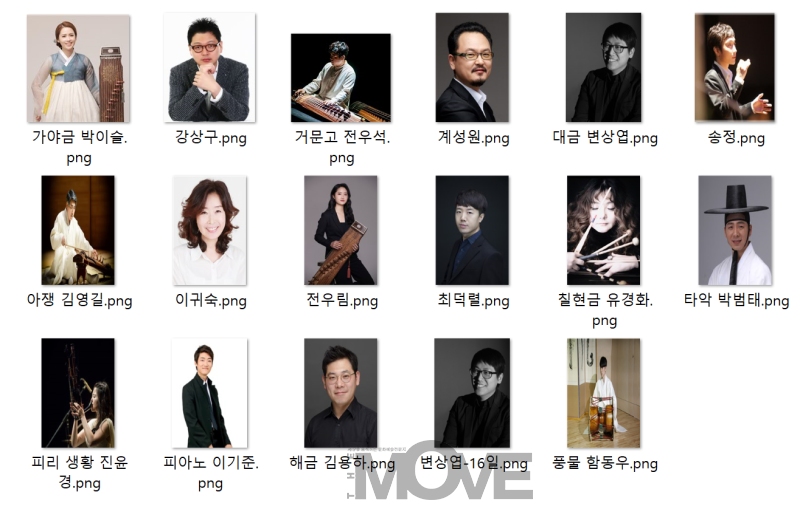 |
| 9.16 참여 아티스트들 |
program
9월 16일
1. 검은등 뻐꾸기 작곡_전우림
가야금_전우림 장구_함동우
이 작품은 ‘검은등뻐꾸기의 울음소리’를 모티브로 작곡되었다. 검은등뻐꾸기의 울음은 일반 뻐꾸기의 울음과 다르게 4가지의 음정으로 구성되어 있는데, 이로 인해 한국에서는 ‘하하호호 새’로 불리기도 한다. 산조 가야금과 장구를 위한 곡 ‘검은등뻐꾸기’는 알을 깨고 태어나는 모습과 그 이후의 일대기를 담았는데, 가야금의 주법인 전성을 사용해 부리로 알을 깨려 노력하는 모습을, 좌단과 뒷판을 쳐서 알이 결국 깨지는 모습을 표현하고자 했다. 이후 한국의 전통 민요인 ‘새타령’의 가락을 인용해 새가 자유롭게 날아다니는 모습을 묘사하였고, 다시 앞부분을 전조시켜 검은등뻐꾸기가 알을 깨는 모습으로 곡은 마무리 된다. 작곡가는 이 곡을 통해 검은등뻐꾸기처럼 '쉽게 포기하지 않고, 노력하며 살아가자'는 내용을 말하고자 했다.
(Eng)
1. Black back cuckoo /Composer_woorim, Chun
Gayageum_woorim, Chun Janggo_dongwoo, Ham
The sound of dark-back-cuckoo(Cuculus micropterus) is the main motif of this music. They can chatter four different pitches. It is often called as the Hahahoho bird in Korea due to their such an unique melody. This music contains the hatching moment of the bird, and the rest life stories. One of the special fingerings of the gayageum, called Jeonseong, was introduced to express the moment of hatch. In addition, familiar folksong melody was attached to the back of the piece to describe the flying bird in the sky.
(한글)
2. 흩은가락 구성 및 편곡_김영길, 류경화
아쟁_김영길 철현금_류경화
흩은 가락은 고강한 연주력으로 산조, 시나위, 민요, 정악 그리고 프리뮤직의 음악어법을 가지고 자유로운 즉흥 연주를 시도하는 작품이다. Jazz나 시나위에서처럼 리듬과 장단의 틀을 약속하고 그 위에서 철현금과 아쟁 연주자가 직관적 연주를 서로 대화하고 때론 대음 하면서 음악을 이끌어 간다.
프리템포의 다스름으로 시작하여 6박, 12박, 4박, 5박의 다양한 리듬 안에서 전통적 기법과 현대적 기법을 조화롭게 엮어간다.
(Eng)
2. Scattered melody /Arrangement_Young kil Kim Kyunghwa, Ryu
Ajaeng_young kil, Kim Cheolhyeongeum_Kyunghwa, Ryu
This work is a new attempt to ensemble various genres of Korean music such as Sanjo, Sinawi, Folksong, Classical music, and Free music by utilizing its musical grammar in free style. As we promise certain structures of the rhythm earlier, and string instrument players make intuitive dialogue or polyphony. Many variants of rhythm in 6, 12, 4, 5 beat combinations are to be seen both in traditional and modern way of technique.
(한글)
3. 현(絃)-흉(凶)-한(恨) 작곡_송 정
가야금_박이슬 거문고_전우석 아쟁_김영길
3대의 현악기를 통해 '흉'을 집중적으로 강조하고 '한'으로 풀어내도록 했다.
아름다움 가득할 아이들이 차가운 바다에 빠지는 흉한 일. 그것은 현 시대를 살아가는 너와 내가 가슴 속으로 깊숙이 쌓은 한(恨)일 것이다. 모두의 염원이 담긴 치유의 시간이 역정의 시절을 지내온 개인의 독자적인 아픔이 아니라 시대를 초월하는 모두의 염원이길 바란다.
'한은 곧 한국의 정서'라고 볼 수는 없다. 한국은 유구한 역사를 통해 숙성된 결정처럼 '한(恨)'의 정서를 가슴에 품는다. 이 작품이 상처받은 한을 위로해 줄 일부라도 되어 가슴 속 응어리를 풀어내길 바란다.
이 아픈 마음 어찌 두고 가시오...
(Eng)
3. Hyeon-Hyung-Han / Composer_jung, Song
Ajaeng_young kil, Kim Gayageum_yiseul, Park Geomungo_wooseok, Jeon
The composer tried to express and interpret the deep sorrow by three string instruments. When the children were drawn in the sea, such a tragedy becomes the deep sorrow in our heart. May the time of cure, holding everyone’s pray, be the timeless wish beyond the individual pain. The deep sorrow, “han(한, 恨),” is not Korea’s genuine emotion. Koreans only have the emotion in their heart crystalized through the history.
(한글)
4. 세한도 작곡_강상구
피리_ 진윤경
넉넉한 가정에서 평화로운 삶을 살았던 조선후기의 학자 김정희는 세파에 시달리며 제주도로 유배를 가게 되었다. 모든 것이 상실되는 감정을 느끼고 어렵게 살고 있던 김정희에게 의리를 지켜준 제자 이상적의 모습은 그를 감동시켰다. 많은 것을 잃었던 추사 김정희에게 보여준 우선 이상적의 모습은 세상을 살아가는데 한줄기 빛이었을 것이다. 추사 김정희는 변함없는 신뢰를 보여준 우선 이상적에게 논어의 한 구절을 담아 그림을 그렸다. 겨울이 되고서야 소나무와 잣나무가 시들지 않는다는 사실을 그림에 담은 이 세한도는 그런 의미에서 진정한 관계에 대한 감동을 담은 그림이라고 하겠다. 요즘 현대사회에서 사람들의 관계는 더 많아지고 있으나 진정한 관계가 무엇인지 생각해 보게 한다. 오늘 선보이는 세한도는 피리를 중심으로 쓰여졌고 피리의 꿋꿋한 소리를 통해 소나무의 변함없는 정신을 생각하기를 기대한다.
(Eng)
4. Sehando / Composer_sang goo, Kang
Piri_ yunkyong, Jin
One of the outstanding scholar—Gim Jeonghui lived in exile during the Joseon period. Since he was living in a generous family, it was a very suffering time in his life. While Mr. Gim was feeling everything in vain, one of his student, Yi Sangjeok, offered his best manner to Mr. Gim by keeping a loyalty next to him. Mr. Gim left a painting for Yi, and there was a pine tree, meaning it never withers even in Winter. The title of the painting is <Sehando>. With such a meaning, the image tells about a real touch among people. It reminds us what the real relation is in our modern life.
5. 시르실 III 작곡_최덕렬
해금_김용하 거문고_전우석 기타_최덕렬
‘시르실 III'는 전통춤 태평무의 반주음악으로 사용되는 ’도살풀이‘ 선율을 주요 모티브로 하여, 지영희류 해금산조와 신쾌동류 거문고산조 자진모리 가락에 새로운 색을 입힌 곡이다. ’한‘과 같은 진한 슬픔의 감정을 대표하는 남도지방의 계면조선율을 대중들이 공감할 수 있는 방식으로 풀어내보고자 하였다. ‘시르실’은 실(絲)과 실이 만난다는 의미로, 국악 현악기를 주요 소재로 삼는 작곡가의 실내악 연작 시리즈이다
(Eng)
5. Sireusil III / Composer_deokyol, Choi
Haegeum_younghwa, Kim Geomungo_wooseok, Jeon Guitar_deokyol, Choi
This work adopts a motif from one of the traditional dance repertoire’s accompaniment music: Dosalpuri. Also, the music adopted the melody of Ji Yeonghui’s haegeum sanjo and that of the Sin Kwedong’s geomungo sanjo. The deep sorrow is well expressed in the Southern parts of Korean peninsula, and its unique feelings were brought into the music so that the audience can empathize. The title “Sireusil” implies a thread crosses another thread, which symbolizes string instruments in the other hand.
(한글)
6. 대금, 가야금, 거문고를 위한 3중주 <다시!> 작곡_ 계성원
가야금_박이슬 거문고_전우석 대금_변상엽
‘다시(Again)'는 ’포기(Give up)'의 반대말이다. 최소한 나에게는...
계속되는 실패로 낙심과 절망에 빠질 때마다 새 힘을 얻기 위해 외치는 내면의 소리, ‘다시!’
나의 ‘다시’는 단순하고 무의미한 ‘반복(repeat)'이 아니며, 지난 시간에 대한 반성과 더 나은 미래를 위한 결단의 외침이다. 어쩌면 지금의 나는 그 동안 수 많은 ’다시!‘를 외치며 다듬어져 왔는지도 모른다. 그래서 나는 과거에도 그랬듯이 ’포기‘의 유혹이 다가올 때마다 ’다시!‘를 외칠 것이다. 지금 이순간, 어디에선가 ’포기‘의 유혹 앞에 서 있을 나의 친구들과 이웃들도 나와 함께 ’다시!‘를 외치며 힘차게 다시 일어서기를 소망하며, 그 마음을 대금, 가야금, 거문고 3중주의 가락 속에 담았다.
(Eng)
6. <Again!> Trio for Daegeum, Gayageum, Geomungo /Composer_sung won, Kea
Gayageum_Yiseul, Park Geomungo_Wooseok, Jeon Daegeum_ Sangyeop, Byun
“Again” is to be the antonym of “Give up”, at least to me.
The inner cheers from myself whenever I fell into the continuous failure: “Again.”
My “Again” is not monotonous nor meaningless “repeat.” It is closer to the shouting of a decision for the better future with regrets of my past. I may have shouted countless “Again” to refine myself. So, I will shout out “Again” whenever the temptation—so-called “Give up”―approaches to me. I wish we all cheer up and shout out: “Again” with those who may face the temptation of “give up.” With all my heart, the melody is held in daegeum, gayageum, and geomungo trio.
(한글)
7. 피아노와 2인 타악주자를 위한 “더미(clusters)” 작곡_이귀숙
피아노_이기준 타악1_박범태 타악2_함동우
이 작품은 경기도당굿과 동해안 별신굿 장단을 토대로 동서양 악기의 다채로운 음향적, 리듬적 실험을 통해 산출된 곡이다. 작품의 음악구조는 고요한 피아노 서주로 시작하여 올림채 몰이-피아노 간주-제마수-드렁갱이 2장-도살풀이-도살풀이몰이-발뻐드레-드렁갱이 5장으로 변화무쌍하게 전개된다. 이 곡에서 피아노는 톤 클러스터(tone cluster)를 포함한 현대화성 및 폭넓은 음역에서의 타악기적 주법을 통해 굿장단과 상호 결합하여 특유의 음향효과를 표출하였고, 부분적으로는 음악적 재료의 제시, 반복, 점진적인 변화를 통한 미니멀 작곡기법이 접목되었다. 이 작품은 전 세계로 확산된 코로나 바이러스 더미(clusters)로 인한 혼란, 충격, 멈춤, 회복, 위로, 희망 그리고 극복의 메시지를 담아 작곡되었다. 또한 한국전통장단과 서양 피아노 음악어법의 절묘한 결합을 통해 전 세계인이 화합하여 코로나19를 이겨내고 회복되어, 우리 모두 다시 하나 되길 간절히 바란다
(Eng)
7. “Clusters” for piano and two percussionists /Composer_gui sook, Lee
Piano_Kijun, Lee Percussion1_Bumtae, Park Percussion2_ Dongwoo, Ham
The music was born through the various experiments of sound and rhythm of the West and East based on the rhythmic patterns found in shaman music from two different parts of Korean peninsula. The total piece consists of 5 movements beginning with piano solo. The piano expresses unique sound effects with percussion-like technique and contemporary harmony in larger registers including tone-clusters combined with rhythmic patterns of Korean shaman music. Partially, it introduces the presentation of musical material, repeat, and minimal-composition method by progressive change. This work conveys many massages such as the chaos of virus clusters, shock, halt, recovery, consolation, hope, and overcome under widely spread COVID-19 situation all over the world. Also with such a subtle combination of Korean rhythm and piano, may we all overcome and recover from the COVID-19 to bring us back to one unity again.
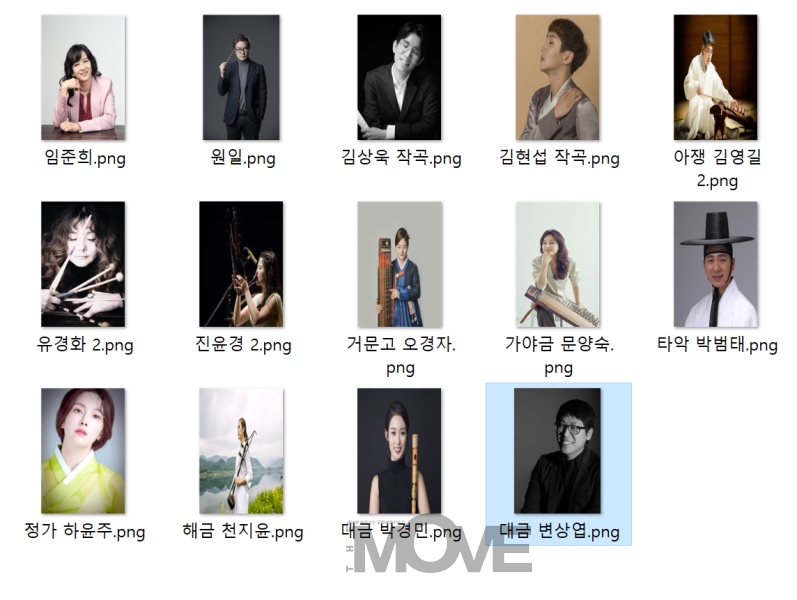 |
| 9.21 참여 아티스트들 |
program
9월 21일
1. 댄싱산조 3 작곡_임준희
가야금_문양숙 피아노_벤킴 바이올린_강별
산조는 절제되어 있으되 그 속에서 즉흥적 요소를 자유롭게 구사할 수 있는 한국 기악 독주곡의 대표적인 양식이다. 이 작품은 이러한 산조의 독주적 특징을 가야금, 바이올린, 피아노의 결합으로 확대시켜 산조가 내포하고 있는 정교한 선율적 짜임새와 리듬적 역동성을 해체하고 재결합하여 보다 확장된 음향적 구축물로 표현하고자 시도한 세 번째 작업이라고 할 수 있다.
이러한 시도는 단선율의 multiphonic sound적인 확장, 긴장과 이완의 보다 급격한 완급 조절, 다향한 음향적 결합등으로 표현되어진다. 또한 댄싱산조 3에서는 자진모리, 휘모리 등 한국 고유의 전통장단의 활용은 물론 한국 굿장단의 적극적인 활용을 통해 작품에 역동성과 생동감을 더하고자 하였다. 이러한 새로운 음향적 결합에 대한 모색이 이 시대의 화두가 되고 있는 공존과 공감, 열린 세계에 대한 관심들에 주목하는 계기가 될 수 있길 바란다.
1. Dancing Sanjo 3 /Composer__June-hee, Lim
Gayageum_yang sook, Moon Piano_벤킴 Violin_강별
Sanjo is one of the representative solo instrumental genre in Korean music with well-organized melody and improvisational elements. The work expands its original characteristics bringing the combination among gayageum, violin, and piano. The work’s purpose was to deconstruct such dedicate organizations and dynamic aspects in sanjo and to reunite them in an expended result of the sound as the third attempt.
Such attempts bring the expansion from monophony to multiphony in sound, and the control of the tension and relax, or the combination of various sound sources, and so on.
In <Dancing Sanjo 3>, dynamicity and vitality is appeared more dramatically, not only by the Korean genuine rhythms, but also with the rhythmic patterns used in Shaman rituals.
(한글)
2. 秋扇 _추선 작곡_최우정
정가_하윤주 피아노_벤킴
한국 전통가곡과 서양 예술가곡의 만남을 통해 새로이 불릴 이번 앨범 ‘Chu-Sun(Autumn Fan) (秋扇)’은 ’사랑을 하다 헤어진 여자의 마음‘을 주제로 하고 있다. 새로운 옷을 입고 한들거릴 노래와 조화를 이루며 만들어 낼 소리로 가득 채워진 소리의 정원을 상상해보며, 전통가곡과 서양 예술가곡의 융합을 통해 새롭고 다양한 발전 가능성을 엿볼 수 있다. 음역대가 넓고 곡에 따라 다양한 분위기를 만들 수 있는 피아노를 반주로 사용함으로써 국악기가 지닌 화성의 한계를 뛰어넘고 악기 특유의 서정적인 분위기를 담은 이번 앨범의 작곡은 최우정(서울대학교 음악대학 작곡과 교수), 작사는 극작가 배삼식(한국예술종합학교 극작과 교수)이 함께 하였다.
(Eng)
2. Chu-Sun(Autumn Fan) /Composer__U zong, Choe
Vocal_yun ju, Ha Piano_벤킴
The ‘Chu-Sun (Autumn Fan)’ will be newly sung through the convergence of the Jeong-ga(Korean traditional song) and the Western art song, with the theme “the heart of a woman who parted after love”. By imagining the garden of sound filled with the sound to be made by harmonizing with the song waving with new clothes on, listeners will have a look at new and diverse possibilities of development by the convergence of the traditional song and the western art song. By using the piano accompaniment with a wide range of notes and that can create a diverse atmosphere of different songs, the album has overcome the limitation in the chord which the traditional instruments have, and it captured the unique atmosphere of sentimentality the traditional instruments possess. The music was composed by Choe, U Zong (Professor of Composition at Seoul National University) and the verses were written by playwright Pai, Sam Shik (Professor of Playwriting at Korea National University of Arts).
(한글)
3. 망각의 새 작곡_류경화
철현금_류경화 대금_변상엽 타악_박범태 콘트라베이스_이정욱
2004년 유경화 철현금독주회 때 초연된 곡으로 따블라, 거문고와의 콜라보 그리고 협주곡과 월드뮤직등의 다양한 버전으로 연주되어졌다. 끝없이 현재의 자신을 부정하고 망각하며 새로운 자신을 찾는 구도자적 예술가를 표현한 곡이다. 인트로에서는 '새'로 상징되는 수행자 즉 예술가의 숭고함과 새로움에 대한 무의식적 갈망을 표현한다. 두번째 악장은 하나하나의 날개짓, 한발한발의 걸음으로 끝없이 새로운 나를 찾아가는 모습을 철현금의 다이나믹한 주법과 다양한 변박으로 표현한다. 곡의 끝부분은 다시 명상적으로 고난과 수행의 길에서 찾은 새로운 나를 날려 보낸다. 하늘로 날아가는 새의 모습을 철현금의 최고음 음을 사용하여 표현하며 부채의 퍼덕이는 사운드로 새의 힘찬 날개짓을 표현한다.
(Eng)
3. The bird of Oblivion / Composer_Kyunghwa, Ryu
Cheolhyeongeum_Kyunghwa, Ryu Daegeum_ Sangyeop, Byun Percussion_ bumtae, Park Contrabass_이정욱
Its premiere goes back to Ryu KyungHwa’s solo recital in 2004 with the collaboration between the tabla and geomungo, a concerto by world musicians in many different versions. The theme depicts an artist who is continuously looking for oneself and denying the present status of the individual.
The bird, in intro, is a symbol who eagers for the freshness and nobility of an artist. The second movement is expressed in variable rhythmic patterns with the melody of the instrument—Cheorhyeongeum. The final part comes back to blow me off on the way of the ascetic practice.
(한글)
4. 산조의 변형 작곡_김상욱
산조아쟁_김영길 바이올린1_강별 바이올린2_이명은 비올라_이상윤 첼로_최하영
이 곡은 19-20세기에 발전된 전통 기악 독주 음악 ‘산조’에 영감을 받아 만들어졌다. 곡의 서사는 아쟁의 선율과 ‘시김새’(음정 변화주법)는 현악 4중주의 미분음, 특수주법과 만나 음향이 확장, 발전하며 만들어진다. 각기 다른 전통의 유사성과 차별성을 감상할 수 있도록 각각의 음악적 스타일과 악기의 특징을 강조하였다.
(Eng)
4. Metamorphosis of Sanjo / Composer_Sanguk, Kim
Ajaeng_young kil, Kim Violin 1_강별 Violin 2_이명은 Viola_이상윤 Cello_최하영
Sanjo is a recent style of traditional Korean music developed by instrumental virtuosos. Its organic way of weaving melodies and use of sigimsae, pitch manipulating techniques, are the remarkable musical traits. The term of sanjo literally means 'scattered melodies,' and it inspired me to write 'Metamorphosis of Sanjo' by reconstructing the skeleton of the traditional melodies, timbre and acoustics. With a blend of bowed instruments from different traditions, but highlighting their differences, I seek an interaction between cultural polarities. Pairing the Korean sigimsae with the western extended techniques was a pleasure of the compositional process.
(한글)
5. 안중지음(眼中之音) 작곡_김현섭
거문고_오경자 타악_박범태 피아노_김현섭
안중지음(眼中之音)은 눈(眼)앞에 있는 소리를 가리켜 말하기도 하며, 눈앞에 아른거리는 그리운 소리를 일컫기도 한다. 거문고 명인 신쾌동의 “산조”를 기반으로 작곡가 김현섭이 작곡과 피아노 연주를 맡고, 거문고 연주자 오경자의 가락으로 재구성하였다. 그 옛날 왕산악이 거문고로 세상의 이치를 담아냈듯, 전통음악의 미학을 동시대의 창의적 언어로 표현하고자 하였습니다. 악장은 Piano Solo의 시작으로, 진양조, 중모리, 중중모리, 엇모리, 자진모리, 휘모리장단 순으로 연주된다.
(Eng)
5. Anjungjieum(眼中之音) / Composer_ hyunseob, Kim
Geomungo_kyungja, Oh Percussion_ bumtae, Park Piano_hyunseob, Kim
Anjungjieum(안중지음, 眼中之音) implies the sound in front of the eyes, or the sound longing for. The melody is based on that of Geomungo sanjo master Sin Kwe-dong’s with the piano accompaniment by the composer himself. The geomungo was played by Oh Gyeongja in this piece. The principle of the instrument is very much valued through the contemporary sense in music. The piano solo begins the piece with movements of Jinyangjo, Jungmori, Jungjungmori, Eonmori, Jajinmori, and Hwimori Jangdan in sequence.
(한글)
6. 정가 “파초우(芭蕉雨)” 작곡_임준희
정가_하윤주 가야금_문양숙 생황_진윤경 피아노_벤킴 플룻_박한나
이 작품은 한국의 대표적인 청록파 시인인 조지훈(1920~1968)의 시 파초우(芭蕉雨)에서
영감을 받아 시의 이미지를 정가(한국 전통성악곡)와 가야금, 피아노, 생황과 플룻으로 표현한
작품이다. 저녁 어스름, 파초잎에 떨어지는 빗소리를 들으며 자연과 하나가 되는 물아일체(物我一體)를 노래한 시의 언어는 함축적이고 간결하나 상념이 깊어 이를 절제되어 있으되 긴 호흡이 유연한 한국의 전통성악곡인 정가의 어법으로 표현하고자 하였다.
“후두기는 빗소리”, “물소리”, “푸른 산과 마주 앉아라~”등으로 표현된 시의 이미지들은 성악 선율의 응축된 소리의 농담의 변화와 피아노, 가야금의 점묘적인 리듬의 변주에 생황, 풀륫의 색채의 변주등이 더해져 공감각적인 소리의 어우러짐으로 묘사된다.
(Eng)
6. Pacho-Woo, Raining on the Plantain Leaf / Composer_ june hee, Lim
Vocal_yun ju, Ha Gayageum_yang sook, Moon Saenghwang_yunkyong, Jin Piano_벤킴 Flute_박한나
The composer was motivated by the poem “Pachou” written by Jo Jihun(1920-1968), who is one of the representative and highly esteemed poet in Korea. The image from the poem was reflected through Korean traditional instruments such as Gayageum, Saenghwang, and as well as piano and flute.
Listening to the raindrops on leaves in the evening, one can accomplish an unity with the surrounding nature. The poem is compressed in language, while the vocal song takes a deep breathing. The light and shade sides of the sound will manifest synesthetics in harmony.
(한글)
7. 0000 작곡_원 일
대금_박경민 해금_천지윤 비올라_이상윤 첼로_최하영
엇농 (Eot-Nong) 삐뚜로 벗어난다, 어긋나다 , 높여서 부르는 노래 라는 의미를 지닌 ‘엇’자와 전통가곡에서 멋드러지게 흥청거린다는 뜻의 ‘농’(弄)자를 결합한 제목.
한국 전통음악의 5음음계와 반음계적 선율들의 어울림과 소리 표현들이 섞여 현대인들에게 내재하는 과거와 현재 문화의 이중적인 흐름과 공존을 소리의 이미지로 상상하며 창작해보았다.
해금과 비올라 ,첼로와 대금의 4중주는 때로는 물과 기름같고 때로는 물속에 퍼지는 먹과 같다.
(Eng)
7. 0000 Composer_ Il, Won
Daegeum_kyoungmin, Park Haegeum_ji yoon, Chun Viola_이상윤 Cello_최하영
Something goes astray, something sways elegantly. The pentatonic and chromatic scale may blend the expressions in music. The intrinsic past and present within us was recreated as the image of sound. The quartet of the haegeum, viola, cello, and daegeum sometimes seem like the water and oil, or a paint in the water.
program
9월 21일
1. 댄싱산조 3 작곡_임준희
가야금_문양숙 피아노_벤킴 바이올린_강별
산조는 절제되어 있으되 그 속에서 즉흥적 요소를 자유롭게 구사할 수 있는 한국 기악 독주곡의 대표적인 양식이다. 이 작품은 이러한 산조의 독주적 특징을 가야금, 바이올린, 피아노의 결합으로 확대시켜 산조가 내포하고 있는 정교한 선율적 짜임새와 리듬적 역동성을 해체하고 재결합하여 보다 확장된 음향적 구축물로 표현하고자 시도한 세 번째 작업이라고 할 수 있다.
이러한 시도는 단선율의 multiphonic sound적인 확장, 긴장과 이완의 보다 급격한 완급 조절, 다향한 음향적 결합등으로 표현되어진다. 또한 댄싱산조 3에서는 자진모리, 휘모리 등 한국 고유의 전통장단의 활용은 물론 한국 굿장단의 적극적인 활용을 통해 작품에 역동성과 생동감을 더하고자 하였다. 이러한 새로운 음향적 결합에 대한 모색이 이 시대의 화두가 되고 있는 공존과 공감, 열린 세계에 대한 관심들에 주목하는 계기가 될 수 있길 바란다.
1. Dancing Sanjo 3 /Composer__June-hee, Lim
Gayageum_yang sook, Moon Piano_벤킴 Violin_강별
Sanjo is one of the representative solo instrumental genre in Korean music with well-organized melody and improvisational elements. The work expands its original characteristics bringing the combination among gayageum, violin, and piano. The work’s purpose was to deconstruct such dedicate organizations and dynamic aspects in sanjo and to reunite them in an expended result of the sound as the third attempt.
Such attempts bring the expansion from monophony to multiphony in sound, and the control of the tension and relax, or the combination of various sound sources, and so on.
In <Dancing Sanjo 3>, dynamicity and vitality is appeared more dramatically, not only by the Korean genuine rhythms, but also with the rhythmic patterns used in Shaman rituals.
(한글)
2. 秋扇 _추선 작곡_최우정
정가_하윤주 피아노_벤킴
한국 전통가곡과 서양 예술가곡의 만남을 통해 새로이 불릴 이번 앨범 ‘Chu-Sun(Autumn Fan) (秋扇)’은 ’사랑을 하다 헤어진 여자의 마음‘을 주제로 하고 있다. 새로운 옷을 입고 한들거릴 노래와 조화를 이루며 만들어 낼 소리로 가득 채워진 소리의 정원을 상상해보며, 전통가곡과 서양 예술가곡의 융합을 통해 새롭고 다양한 발전 가능성을 엿볼 수 있다. 음역대가 넓고 곡에 따라 다양한 분위기를 만들 수 있는 피아노를 반주로 사용함으로써 국악기가 지닌 화성의 한계를 뛰어넘고 악기 특유의 서정적인 분위기를 담은 이번 앨범의 작곡은 최우정(서울대학교 음악대학 작곡과 교수), 작사는 극작가 배삼식(한국예술종합학교 극작과 교수)이 함께 하였다.
(Eng)
2. Chu-Sun(Autumn Fan) /Composer__U zong, Choe
Vocal_yun ju, Ha Piano_벤킴
The ‘Chu-Sun (Autumn Fan)’ will be newly sung through the convergence of the Jeong-ga(Korean traditional song) and the Western art song, with the theme “the heart of a woman who parted after love”. By imagining the garden of sound filled with the sound to be made by harmonizing with the song waving with new clothes on, listeners will have a look at new and diverse possibilities of development by the convergence of the traditional song and the western art song. By using the piano accompaniment with a wide range of notes and that can create a diverse atmosphere of different songs, the album has overcome the limitation in the chord which the traditional instruments have, and it captured the unique atmosphere of sentimentality the traditional instruments possess. The music was composed by Choe, U Zong (Professor of Composition at Seoul National University) and the verses were written by playwright Pai, Sam Shik (Professor of Playwriting at Korea National University of Arts).
(한글)
3. 망각의 새 작곡_류경화
철현금_류경화 대금_변상엽 타악_박범태 콘트라베이스_이정욱
2004년 유경화 철현금독주회 때 초연된 곡으로 따블라, 거문고와의 콜라보 그리고 협주곡과 월드뮤직등의 다양한 버전으로 연주되어졌다. 끝없이 현재의 자신을 부정하고 망각하며 새로운 자신을 찾는 구도자적 예술가를 표현한 곡이다. 인트로에서는 '새'로 상징되는 수행자 즉 예술가의 숭고함과 새로움에 대한 무의식적 갈망을 표현한다. 두번째 악장은 하나하나의 날개짓, 한발한발의 걸음으로 끝없이 새로운 나를 찾아가는 모습을 철현금의 다이나믹한 주법과 다양한 변박으로 표현한다. 곡의 끝부분은 다시 명상적으로 고난과 수행의 길에서 찾은 새로운 나를 날려 보낸다. 하늘로 날아가는 새의 모습을 철현금의 최고음 음을 사용하여 표현하며 부채의 퍼덕이는 사운드로 새의 힘찬 날개짓을 표현한다.
(Eng)
3. The bird of Oblivion / Composer_Kyunghwa, Ryu
Cheolhyeongeum_Kyunghwa, Ryu Daegeum_ Sangyeop, Byun Percussion_ bumtae, Park Contrabass_이정욱
Its premiere goes back to Ryu KyungHwa’s solo recital in 2004 with the collaboration between the tabla and geomungo, a concerto by world musicians in many different versions. The theme depicts an artist who is continuously looking for oneself and denying the present status of the individual.
The bird, in intro, is a symbol who eagers for the freshness and nobility of an artist. The second movement is expressed in variable rhythmic patterns with the melody of the instrument—Cheorhyeongeum. The final part comes back to blow me off on the way of the ascetic practice.
(한글)
4. 산조의 변형 작곡_김상욱
산조아쟁_김영길 바이올린1_강별 바이올린2_이명은 비올라_이상윤 첼로_최하영
이 곡은 19-20세기에 발전된 전통 기악 독주 음악 ‘산조’에 영감을 받아 만들어졌다. 곡의 서사는 아쟁의 선율과 ‘시김새’(음정 변화주법)는 현악 4중주의 미분음, 특수주법과 만나 음향이 확장, 발전하며 만들어진다. 각기 다른 전통의 유사성과 차별성을 감상할 수 있도록 각각의 음악적 스타일과 악기의 특징을 강조하였다.
(Eng)
4. Metamorphosis of Sanjo / Composer_Sanguk, Kim
Ajaeng_young kil, Kim Violin 1_강별 Violin 2_이명은 Viola_이상윤 Cello_최하영
Sanjo is a recent style of traditional Korean music developed by instrumental virtuosos. Its organic way of weaving melodies and use of sigimsae, pitch manipulating techniques, are the remarkable musical traits. The term of sanjo literally means 'scattered melodies,' and it inspired me to write 'Metamorphosis of Sanjo' by reconstructing the skeleton of the traditional melodies, timbre and acoustics. With a blend of bowed instruments from different traditions, but highlighting their differences, I seek an interaction between cultural polarities. Pairing the Korean sigimsae with the western extended techniques was a pleasure of the compositional process.
(한글)
5. 안중지음(眼中之音) 작곡_김현섭
거문고_오경자 타악_박범태 피아노_김현섭
안중지음(眼中之音)은 눈(眼)앞에 있는 소리를 가리켜 말하기도 하며, 눈앞에 아른거리는 그리운 소리를 일컫기도 한다. 거문고 명인 신쾌동의 “산조”를 기반으로 작곡가 김현섭이 작곡과 피아노 연주를 맡고, 거문고 연주자 오경자의 가락으로 재구성하였다. 그 옛날 왕산악이 거문고로 세상의 이치를 담아냈듯, 전통음악의 미학을 동시대의 창의적 언어로 표현하고자 하였습니다. 악장은 Piano Solo의 시작으로, 진양조, 중모리, 중중모리, 엇모리, 자진모리, 휘모리장단 순으로 연주된다.
(Eng)
5. Anjungjieum(眼中之音) / Composer_ hyunseob, Kim
Geomungo_kyungja, Oh Percussion_ bumtae, Park Piano_hyunseob, Kim
Anjungjieum(안중지음, 眼中之音) implies the sound in front of the eyes, or the sound longing for. The melody is based on that of Geomungo sanjo master Sin Kwe-dong’s with the piano accompaniment by the composer himself. The geomungo was played by Oh Gyeongja in this piece. The principle of the instrument is very much valued through the contemporary sense in music. The piano solo begins the piece with movements of Jinyangjo, Jungmori, Jungjungmori, Eonmori, Jajinmori, and Hwimori Jangdan in sequence.
(한글)
6. 정가 “파초우(芭蕉雨)” 작곡_임준희
정가_하윤주 가야금_문양숙 생황_진윤경 피아노_벤킴 플룻_박한나
이 작품은 한국의 대표적인 청록파 시인인 조지훈(1920~1968)의 시 파초우(芭蕉雨)에서
영감을 받아 시의 이미지를 정가(한국 전통성악곡)와 가야금, 피아노, 생황과 플룻으로 표현한
작품이다. 저녁 어스름, 파초잎에 떨어지는 빗소리를 들으며 자연과 하나가 되는 물아일체(物我一體)를 노래한 시의 언어는 함축적이고 간결하나 상념이 깊어 이를 절제되어 있으되 긴 호흡이 유연한 한국의 전통성악곡인 정가의 어법으로 표현하고자 하였다.
“후두기는 빗소리”, “물소리”, “푸른 산과 마주 앉아라~”등으로 표현된 시의 이미지들은 성악 선율의 응축된 소리의 농담의 변화와 피아노, 가야금의 점묘적인 리듬의 변주에 생황, 풀륫의 색채의 변주등이 더해져 공감각적인 소리의 어우러짐으로 묘사된다.
(Eng)
6. Pacho-Woo, Raining on the Plantain Leaf / Composer_ june hee, Lim
Vocal_yun ju, Ha Gayageum_yang sook, Moon Saenghwang_yunkyong, Jin Piano_벤킴 Flute_박한나
The composer was motivated by the poem “Pachou” written by Jo Jihun(1920-1968), who is one of the representative and highly esteemed poet in Korea. The image from the poem was reflected through Korean traditional instruments such as Gayageum, Saenghwang, and as well as piano and flute.
Listening to the raindrops on leaves in the evening, one can accomplish an unity with the surrounding nature. The poem is compressed in language, while the vocal song takes a deep breathing. The light and shade sides of the sound will manifest synesthetics in harmony.
(한글)
7. 0000 작곡_원 일
대금_박경민 해금_천지윤 비올라_이상윤 첼로_최하영
엇농 (Eot-Nong) 삐뚜로 벗어난다, 어긋나다 , 높여서 부르는 노래 라는 의미를 지닌 ‘엇’자와 전통가곡에서 멋드러지게 흥청거린다는 뜻의 ‘농’(弄)자를 결합한 제목.
한국 전통음악의 5음음계와 반음계적 선율들의 어울림과 소리 표현들이 섞여 현대인들에게 내재하는 과거와 현재 문화의 이중적인 흐름과 공존을 소리의 이미지로 상상하며 창작해보았다.
해금과 비올라 ,첼로와 대금의 4중주는 때로는 물과 기름같고 때로는 물속에 퍼지는 먹과 같다.
(Eng)
7. 0000 Composer_ Il, Won
Daegeum_kyoungmin, Park Haegeum_ji yoon, Chun Viola_이상윤 Cello_최하영
Something goes astray, something sways elegantly. The pentatonic and chromatic scale may blend the expressions in music. The intrinsic past and present within us was recreated as the image of sound. The quartet of the haegeum, viola, cello, and daegeum sometimes seem like the water and oil, or a paint in the water.
강영우 기자 press@ithemove.com


